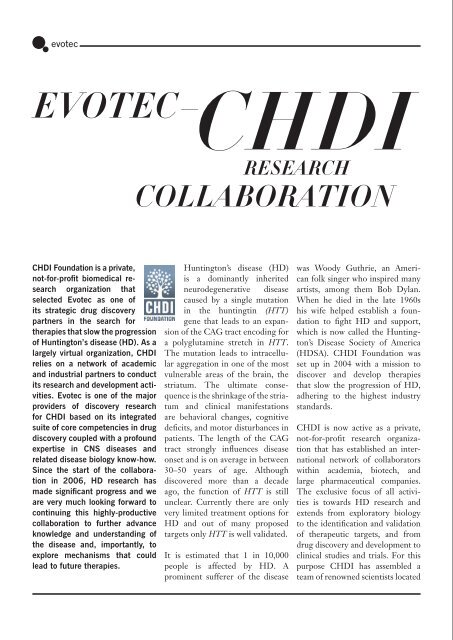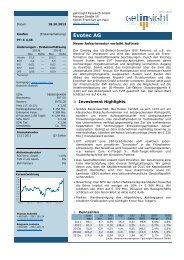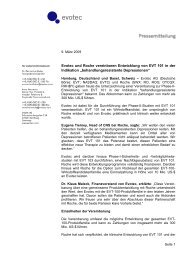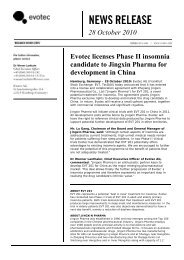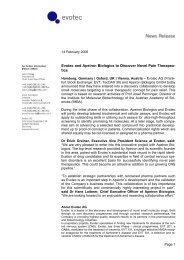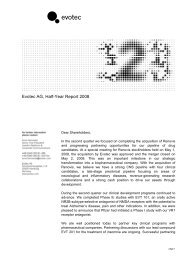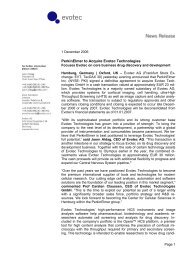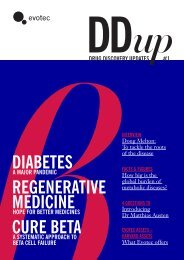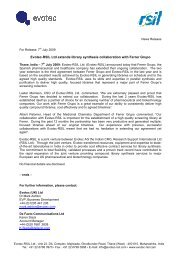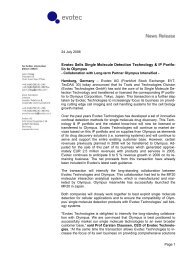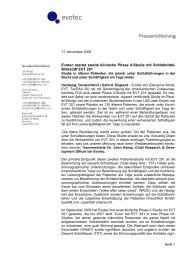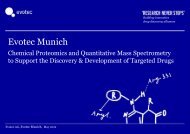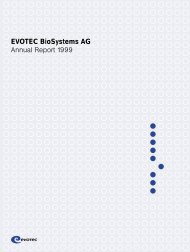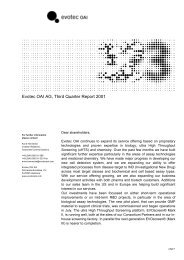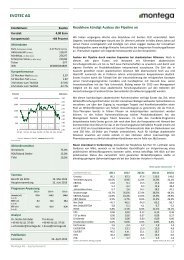Dr anDreas ebnetH - Evotec
Dr anDreas ebnetH - Evotec
Dr anDreas ebnetH - Evotec
Create successful ePaper yourself
Turn your PDF publications into a flip-book with our unique Google optimized e-Paper software.
evotec –<br />
chdi Foundation is a private,<br />
not-for-profit biomedical re-<br />
search organization that<br />
selected evotec as one of<br />
its strategic drug discovery<br />
partners in the search for<br />
therapies that slow the progression<br />
of huntington’s disease (hd). as a<br />
largely virtual organization, chdi<br />
relies on a network of academic<br />
and industrial partners to conduct<br />
its research and development activities.<br />
evotec is one of the major<br />
providers of discovery research<br />
for chdi based on its integrated<br />
suite of core competencies in drug<br />
discovery coupled with a profound<br />
expertise in cnS diseases and<br />
related disease biology know-how.<br />
Since the start of the collaboration<br />
in 2006, hd research has<br />
made significant progress and we<br />
are very much looking forward to<br />
continuing this highly-productive<br />
collaboration to further advance<br />
knowledge and understanding of<br />
the disease and, importantly, to<br />
explore mechanisms that could<br />
lead to future therapies.<br />
CHDI<br />
ReseaRcH<br />
collaboration<br />
Huntington’s disease (HD)<br />
is a dominantly inherited<br />
neurodegenerative disease<br />
caused by a single mutation<br />
in the huntingtin (HTT)<br />
gene that leads to an expansion<br />
of the CAG tract encoding for<br />
a polyglutamine stretch in HTT.<br />
The mutation leads to intracellular<br />
aggregation in one of the most<br />
vulnerable areas of the brain, the<br />
striatum. The ultimate consequence<br />
is the shrinkage of the striatum<br />
and clinical manifestations<br />
are behavioral changes, cognitive<br />
deficits, and motor disturbances in<br />
patients. The length of the CAG<br />
tract strongly influences disease<br />
onset and is on average in between<br />
30–50 years of age. Although<br />
discovered more than a decade<br />
ago, the function of HTT is still<br />
unclear. Currently there are only<br />
very limited treatment options for<br />
HD and out of many proposed<br />
targets only HTT is well validated.<br />
It is estimated that 1 in 10,000<br />
people is affected by HD. A<br />
prominent sufferer of the disease<br />
was Woody Guthrie, an American<br />
folk singer who inspired many<br />
artists, among them Bob Dylan.<br />
When he died in the late 1960s<br />
his wife helped establish a foundation<br />
to fight HD and support,<br />
which is now called the Huntington’s<br />
Disease Society of America<br />
(HDSA). CHDI Foundation was<br />
set up in 2004 with a mission to<br />
discover and develop therapies<br />
that slow the progression of HD,<br />
adhering to the highest industry<br />
standards.<br />
CHDI is now active as a private,<br />
not-for-profit research organization<br />
that has established an international<br />
network of collaborators<br />
within academia, biotech, and<br />
large pharmaceutical companies.<br />
The exclusive focus of all activities<br />
is towards HD research and<br />
extends from exploratory biology<br />
to the identification and validation<br />
of therapeutic targets, and from<br />
drug discovery and development to<br />
clinical studies and trials. For this<br />
purpose CHDI has assembled a<br />
team of renowned scientists located<br />
The figure shows brain sections of a rodent model of Huntington’s disease (Q175) where the pathological aggregation of the mutant huntingtin protein<br />
develops at the age of 2 months (2-m). With progressing age number and size of the aggregates continuously increases. Mutant huntingtin was stained<br />
with an antibody specifically recognizing these aggregates<br />
in Los Angeles, New York City, and<br />
Princeton, managing and financing<br />
a network of approximately 600<br />
scientists in academic and industrial<br />
laboratories worldwide. The<br />
data and research tools generated<br />
by these multiple collaborations are<br />
being made accessible to the whole<br />
HD research community in order<br />
to accelerate the development of<br />
effective therapies for HD.<br />
CHDI is currently pursuing<br />
several specific therapeutic strategies;<br />
the key focus is on lowering<br />
the expression of mutant HTT,<br />
thereby reducing the deleterious<br />
aggregate load in neurons. In addition,<br />
posttranslational modifications<br />
of HTT are being evaluated,<br />
as is the synaptic and metabolic<br />
function of neurons and the clearance<br />
of HTT aggregates. <strong>Evotec</strong> is<br />
playing an active role in most of<br />
these approaches and is currently<br />
involved in up to 10 different<br />
programs ranging from medicinal<br />
chemistry-based small molecule<br />
drug development programs to<br />
sophisticated projects in various<br />
rodent models of HD to identify<br />
and validate therapeutic targets, as<br />
well as stem cell approaches.<br />
The most advanced programme<br />
within the <strong>Evotec</strong>/CHDI collaboration<br />
targets kynurenine monooxygenase<br />
(KMO) via selective<br />
small molecule inhibitors.<br />
Evidence from animal models<br />
indicates that KMO activity may<br />
contribute to the progression of<br />
HD. Starting from early assay<br />
development and initial medicinal<br />
chemistry, joint efforts advanced<br />
the project to clinical candidate<br />
nomination by CHDI with<br />
front-running compounds now<br />
scheduled to enter formal toxicology.<br />
In addition, <strong>Evotec</strong> is significantly<br />
contributing to the KMO<br />
project through its in vivo biology/pharmacology<br />
expertise, for<br />
instance analyzing KMO activity in<br />
rodent models of HD dosed with<br />
small molecules. Furthermore,<br />
<strong>Evotec</strong> is subjecting brain sections<br />
from these animals to high-end<br />
imaging technologies (Opera)<br />
13<br />
for quantitative immunohistochemical<br />
analysis of inflammatory<br />
markers. In another more recently<br />
launched joint project, <strong>Evotec</strong> is<br />
developing small molecule tools<br />
to improve diagnosis and monitoring<br />
of disease progression in<br />
HD patients by means of positron<br />
emission tomography (PET)<br />
that could be critically important<br />
in future clinical trials. Specifically,<br />
<strong>Evotec</strong> is collecting and<br />
analyzing human brain tissue from<br />
HD patients and utilizing its medicinal<br />
chemistry expertise to identify<br />
PET ligands that allow quantitative<br />
determination of HTT aggregate<br />
formation in HD to accompany<br />
clinical studies. To support<br />
and improve the translatability<br />
of results from animal models to<br />
patients, <strong>Evotec</strong> is a member of the<br />
European Neuromodel Initiative,<br />
within which <strong>Evotec</strong> is establishing<br />
cognitive readouts in rodent<br />
models of HD that are expected to<br />
lead to more disease-relevant readouts<br />
and therefore should improve<br />
predictability in advancing projects<br />
to the clinic.


